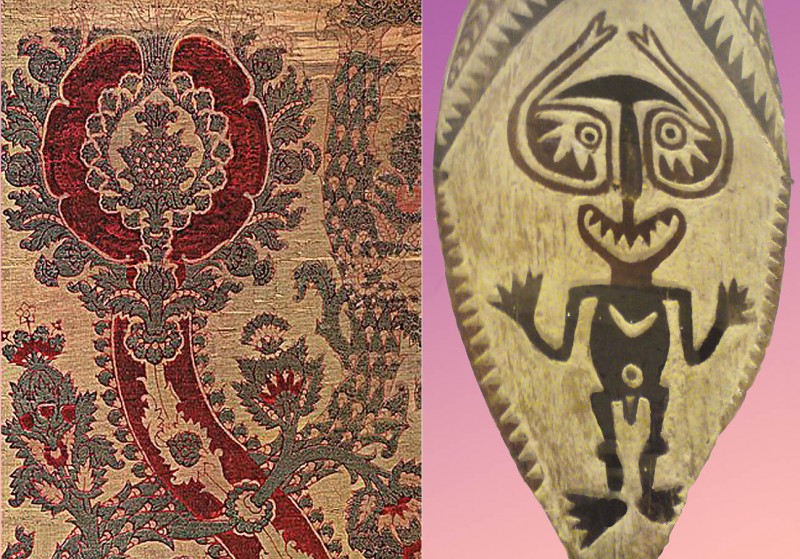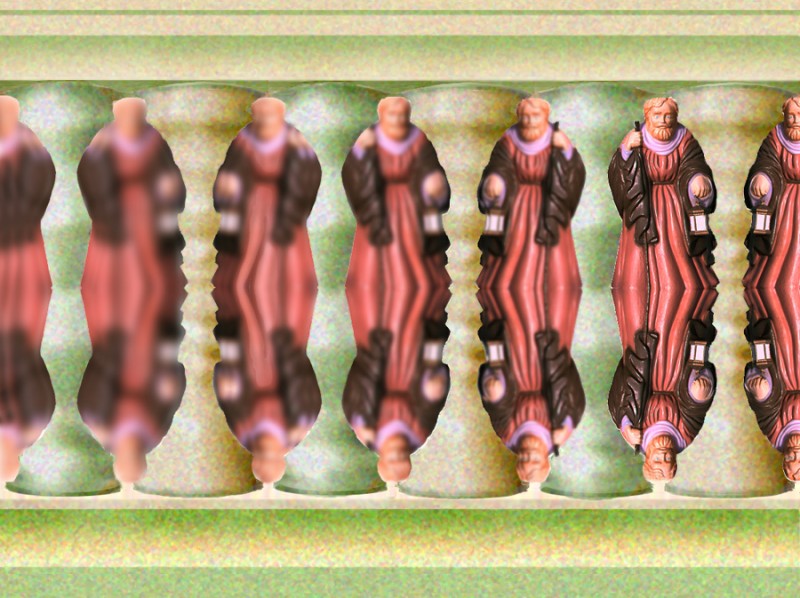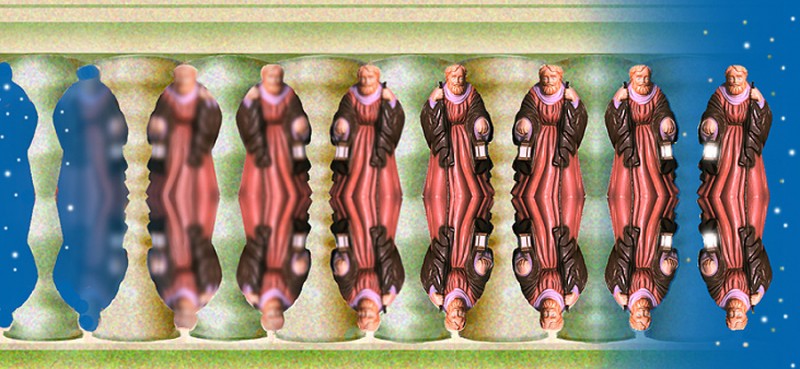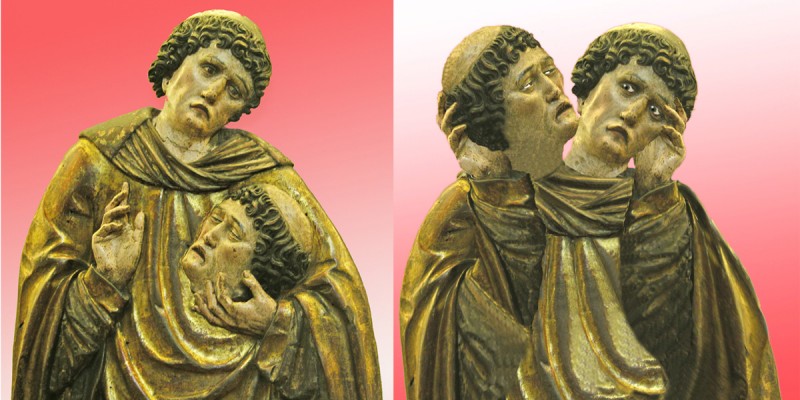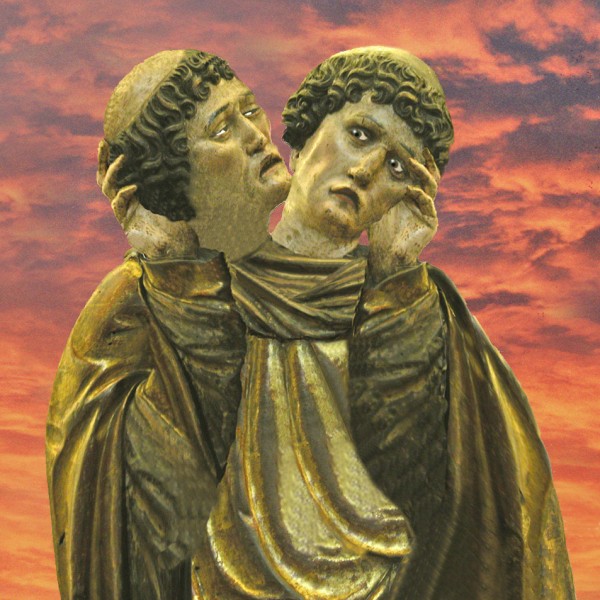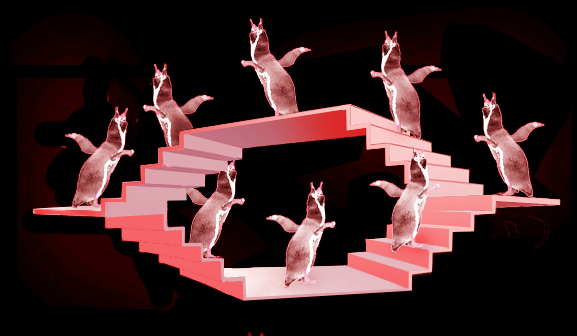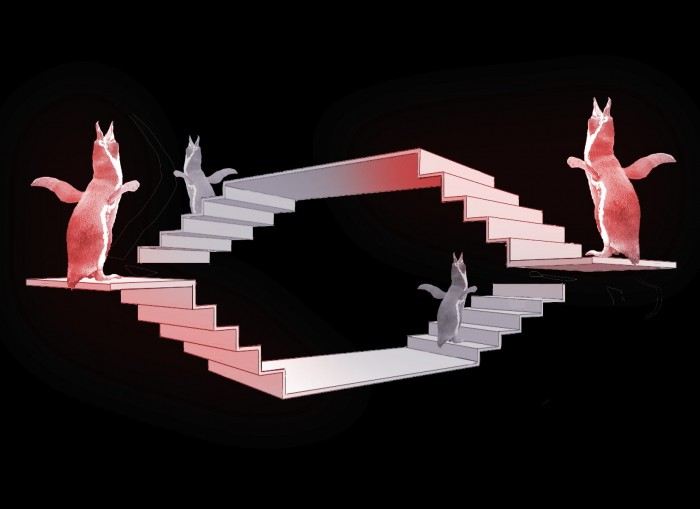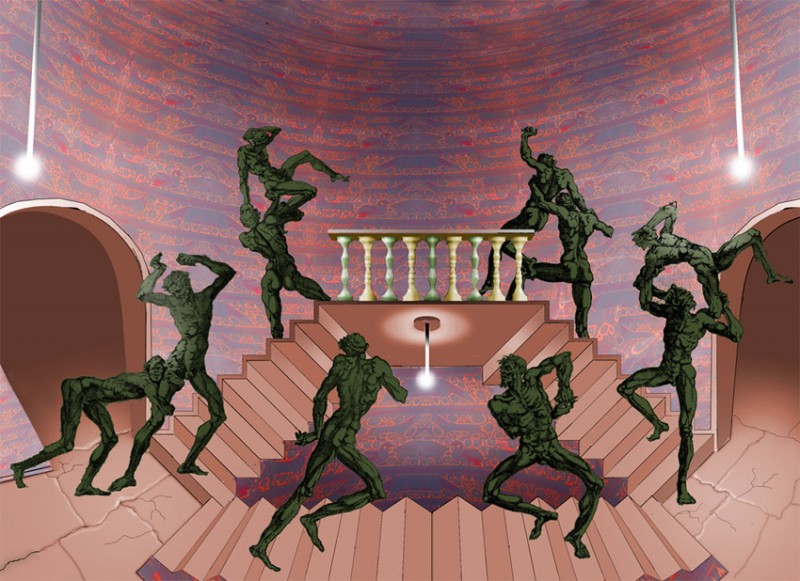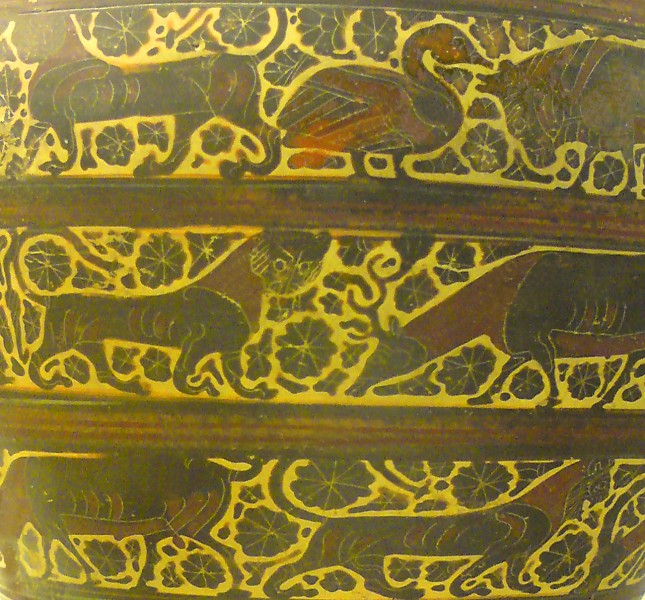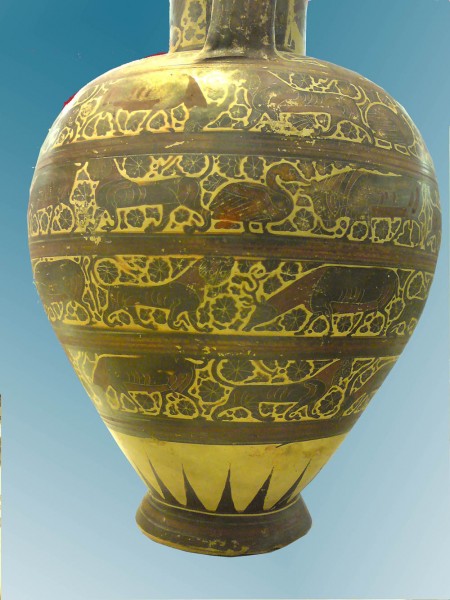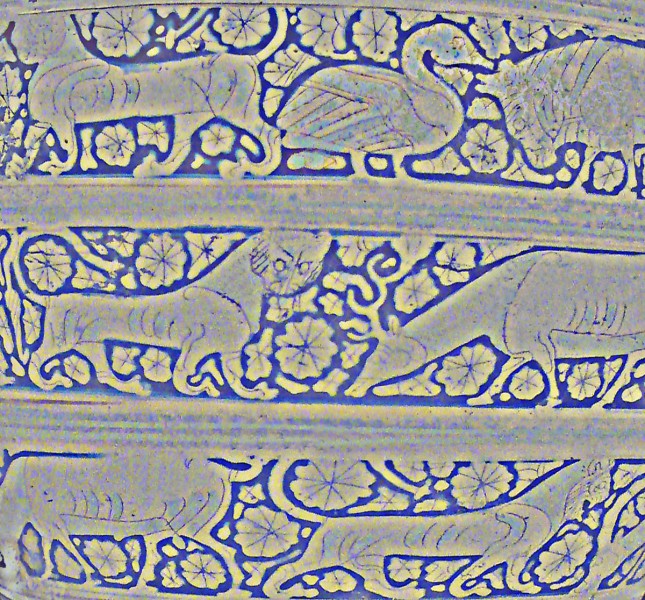It wouldn’t be easy to find two more different artefacts than these. On the left is a silk velvet embroidery made in Italy about five hundred and fifty years ago. On the right is a shield from Koave in Papua New Guinea, made in the last hundred years. Yet they both use exactly the same graphic device, a figure/ground effect.
Category Archives: Optical Illusions
Figure/ground Balustrade Illusion
Here’s another figure/ground effect. A saint becomes a balustrade! Almost any vertical figure whose profile is not too wiggly can be used for this illusion. Below is a different version of it. It’s a little more puzzling, because both saint and balusters, when seen as figure at the ends of the picture, have the same starry sky as background. That’s done by making sure that when saint or balusters are seen as background near the ends of the row, they blur into the same starry night sky.
More Illusion Pictures
Here are some more small optical illusion and visual perception related images you can link to from your own website / profile page.
In case you missed them you can still view the first set of illusion pictures.
Convex/concave spacewarp
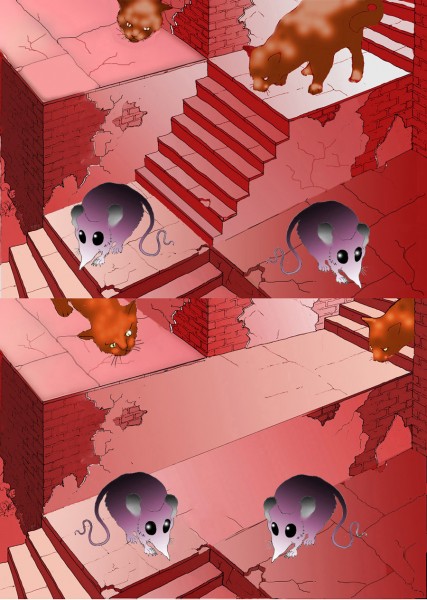
This is about the simplest of all spatial transformations. In the top picture, the mice are at risk from the cats. In the bottom picture, the stairs have vanished, and as the eye travels along the picture from the left, a concave terrace turns into a convex, step shape. There’s now a protective inside/out space-warp between the cats and the mice. I adapted the scene from one I devised for my optical illusion cartoon story. If you wanted to experiment with scenes based on this transformation, the essential scheme is as to the left here. Note that there must be no tonal contrast across the middle line, just in the middle of the image.
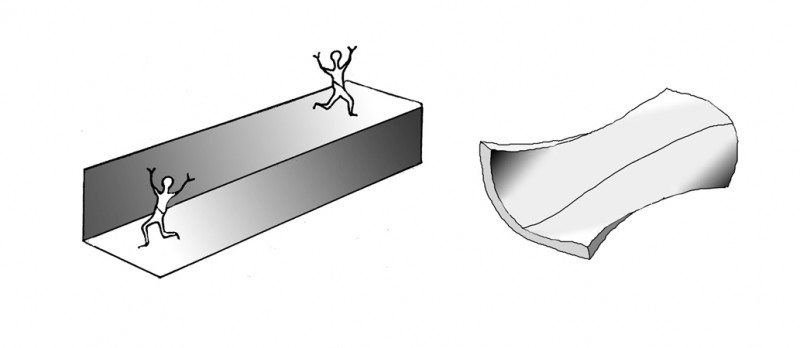 Topologically, I suppose the shape is just a saddle shape, as to the right, so it could exist as a rectangular, 3 dimensional shape, but it would be such an improbable one, and seen from such an unlikely angle, that it looks like an illusion. For a fiendishly clever picture on the theme of inside out transformations, see M.C.Escher’s print Convex/Concave. (Try that title in Google images, or find it on the official Escher website).
Topologically, I suppose the shape is just a saddle shape, as to the right, so it could exist as a rectangular, 3 dimensional shape, but it would be such an improbable one, and seen from such an unlikely angle, that it looks like an illusion. For a fiendishly clever picture on the theme of inside out transformations, see M.C.Escher’s print Convex/Concave. (Try that title in Google images, or find it on the official Escher website).
Outlines, objects and apertures
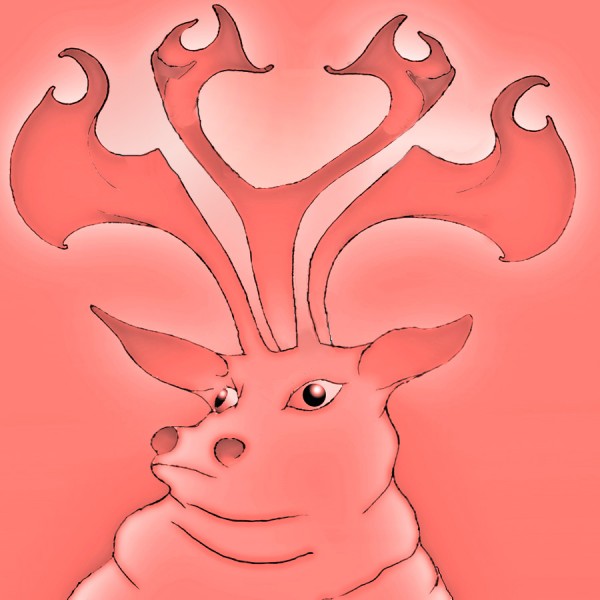
This stag may look OK at first glance (well, you know, sort of…), but hang on, has he got three antlers, as at the top of the picture, or only two, as down by his ears? Following on from the last post, it’s another example of what happens when apertures or gaps in the visual scene – like the segment of starry night in the last post – become objects. But with the stag it’s even weirder, because the middle antler, for example, starts out at the top OK, but by the time it gets down to the stag’s head, it’s become background. Want to know more? Read on!
Halloween magic
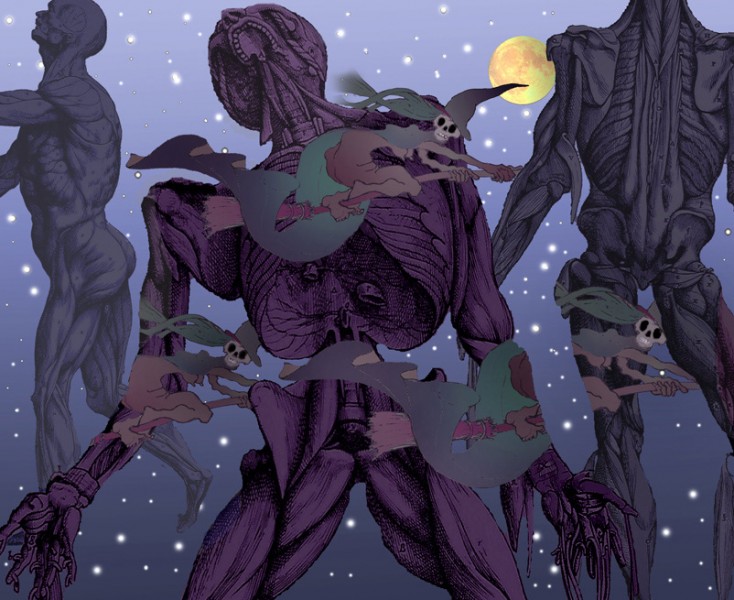
Here’s a scene for Halloween. In our everyday view of the world, the orderly way in which one thing blocks our view of another is something we can depend on to orientate ourselves in the world around us. These witches are breaking the rules. The lower ones appear and disappear at puzzling locations, and the witch lower right even vanishes behind a segment of starry sky. It’s as if the segment of sky had become an object in the visual field, instead of an aperture – an oddly weird effect, for me.
I got the idea from a wonderful painting by Rene Magritte, Carte Blanche. If you go to for that link, you’ll just need to scroll down a couple of pictures – you’re looking for a painting of a lady on a horse in a wood.
Oh, and I borrowed the musclemen from the 450 year old illustrations to the pioneering anatomical studies of Andreas Vesalius.
Improved artworks No 1
Here’s a historic artwork I reckon I’ve much improved. On the left you see it as has been for the last five hundred years or so, a Spanish (I think) wood carving, of a martyred saint, now in the Petit Palais museum in Paris. On the right I’ve turned it into an ambiguous image, in which it’s not clear which head belongs to the body, and which has been chopped off and is being held up for inspection – I think you’ll agree a far more poignant image. It’s an illusion in the style of the Mask/Skull illusion posted earlier.
Here’s a version of my adaptation with an evening sky:
A New(?) Ever Receding Staircase
Here’s a new kind of never-ending stair (I think). It’s like the famous never-ending staircase seen from above by M.C.Escher, called Ascending and Descending. However, in this new staircase instead of figures doomed to go downstairs for ever we have penguins destined to walk away from us forever. It’s based on the geometry of the object in my post on paradoxical size-constancy.
Here’s an animated version:
Like Escher’s famous impossible staircase, (and also as with the impossible tribar), the effect depends on our seeing a scene from a viewpoint from which points that would be at different distances from us seem to connect up. Here’s a view in more usual perspective of one configuration that would give rise to the ever receding staircase above. The trick depends not just on getting the alignment just right, but also on suppressing the usual perspective cues. Size diminution with distance is the most important one. The other is aerial perspective, in which contrast flattens out and colours get bluer with distance. I’ve put them both back below.
For more on staircases like Escher’s famous picture Ascending and Descending …..
Twisted stairs
Here are some crazy stairs. Look at the stairs leading up to the balcony, and at the foot of the stairs you’re looking down on them from above, whilst up by the balcony you’re looking up at them from below. Nothing wrong with that, in a perspective view, but these steps are in a parallel projection, which forbids it. As a result, the side of the steps that’s furthest from us, next to the outer wall down at ground level, has somehow twisted to become the side that’s nearest to the viewer up by the balcony, and vice versa. There’s a different twist to the stairs at the foot of the image. On those, if you start, say, on the right, you’ll find that the flat step surfaces have become vertical risers once you’ve passed the half way mark.
Update May 2012! There’s also a later version of this scene. I wanted to give it another go, because these stairs do have an extra twist to them …..
Puzzling artistic effects
I wrote in an earlier post about how effective decorative motifs can be if they are ambiguous visually or in some other way a bit of a challenge for perception. Why that should be is a mystery, but here’s another of my favourite examples, decoration from a pot made in Corinth, Greece, about 595 BCE.
The pot’s in the British Museum and I guess it’s about 70 cms high. Here’s (nearly) the whole thing.
What’s unusual about this decoration is the way the rosettes and other little decorative motifs in between the animals have expanded to fill almost all the space. In earlier Corinthian decoration, they were much smaller, just little motifs floating in the pale space round the animals. Over two or three decades, painters made them fill more and more of the space, until they left only an outline round each animal. I reckon that shows up better in a version of the first picture which I’ve played around with, and reversed so that the pale outlines are dark.
What’s perceptually puzzling about that, I reckon, is that the brain can’t quite decide whether, in this reversed version, these are animals with strong, dark outlines on a pale background, or pale animals silhouetted on a dark background. If you like doing your own paintings, it’s a brilliant effect to play with, and works just as well with modern motifs, human figures, cars, aeroplanes, umbrellas, you name it.
